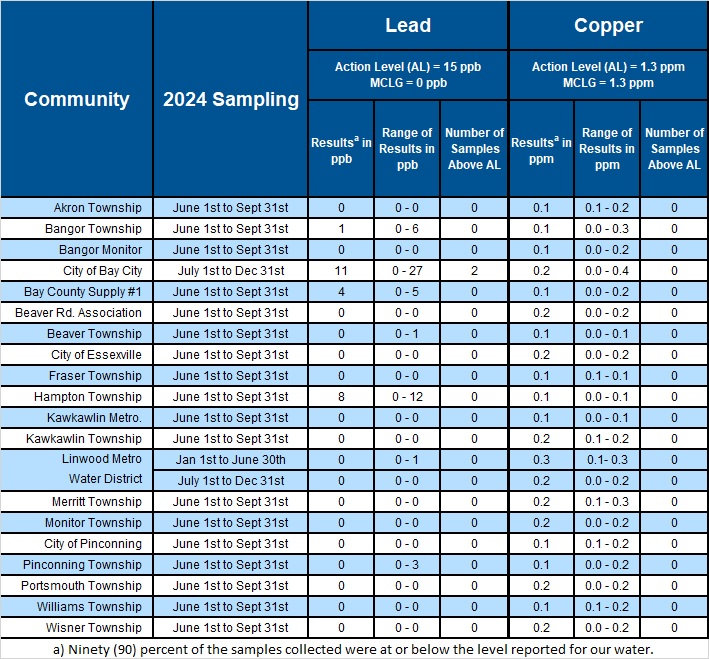Lead and Copper
Lead and copper are not naturally present in our water, and they are not detected in the tap water leaving the plant. However, as long as there are lead services and lead containing fixtures in our water system, there will often be traces of lead detected during testing at locations in the distribution system. In an effort to keep levels low, the water plant feeds phosphoric acid, a corrosion inhibitor. This forms a protective coating on service lines and plumbing that helps reduce water from dissolving metals into the drinking water.
The Bay Area Water System is responsible for providing high quality drinking water, but cannot control the variety of materials used in plumbing components. When your water has been sitting for several hours, you can minimize the potential for lead exposure by flushing your tap for 30 seconds to 2 minutes before using water for drinking or cooking.
Each community served by the Bay County Department of Water and Sewer performs lead and copper testing. Depending on test results, some communities test twice a year, once a year, or once every three years. Samples are collected from homes that are thought to have the highest chance of leaching lead based on service line material and interior plumbing. A certain number of samples are collected in each community based on population.
The EPA has set action levels for both lead and copper based on the 90th percentile. If a community exceeds an action level, they are required to ‘take action’ and work towards reducing the levels. The 90th percentile means that 90% of the samples collected are at or below that level. The lead action level of 15 Parts Per Billion (PPB) was recently lowered to 12 PPB in January of 2025. The copper action level remains the same at 1.3 Parts Per Million (PPM).
The table below shows the most recent test results gathered during 2024.

Information About Lead in Your Drinking Water
General Information, Resources and Websites
- Bay Area Water Systems – YouTube
- Environmental Protection Agency (EPA): Basic Information about Lead in Drinking Water
- EPA infographic of lead sources in your drinking water (PDF)
- Centers for Disease Control (CDC): Lead Exposure Information
- AWWA’s video: Together, Let’s Get the Lead Out
- National Public Radio (NPR) – Do you have lead pipes in your home?
- Michigan Deparmtent of Enviroment, Great Lakes and Energy (EGLE) – Lead and Copper in Drinking Water
- Michigan.gov – Mi Lead Safe
Interactive Tool
How to Tell if You Have Lead Pipes in Your Home
Documents and Brochures
- Reducing Potential Lead Exposure from Drinking Water (PDF)
- Cleaning Your Aerators (PDF)
- Particulate Lead (PDF)
- Potential Impacts of Construction Activity on Water Quality (PDF)
- Identifying Drinking Water Filters Certified to Reduce Lead (PDF)
- How to Identify Lead Free Plumbing Products (PDF)
- Adult Exposure to Lead (PDF)
- Older Adult Exposure to Lead (PDF)
- Lead and Copper Rule Info. Brochure (PDF)
- Lead Poisoning Facts (PDF)
- Lead in Drinking Water (PDF)
- Good Nutrition and Lead (PDF)
- Certified LCR labs (PDF)
Videos
